In this post, we have covered some best free steganography tools to hide text in images for Windows 11/10. In the steganography technique, you can hide secret data or a text message in an ordinary or regular file to avoid detection. The same technique is used in the steganography tools added in this post. These tools support different image types, including PNG, TIFF, BMP, etc. Some of these tools provide the feature to hide EXE or a TXT file in an image file. You only need to make sure that the size of the file that you want to hide or conceal should not be too large to handle for the input file.
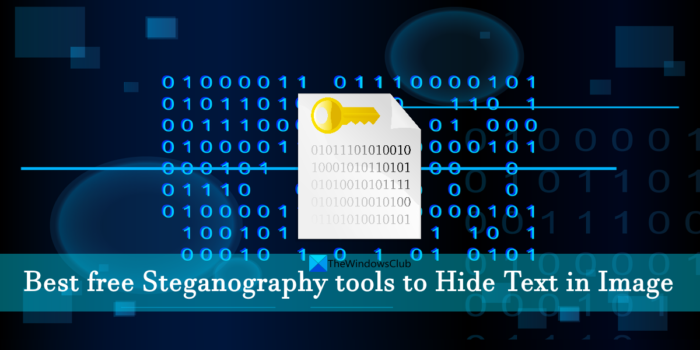
The processed or output image containing the hidden text file or message looks and functions like any other image or photo. You can open it in an image viewer or editor tool. There will be little to no noticeable change. The only difference would be to file size and the fact that it will contain a secret text inside it that can be revealed using the same tool you’re using.
Best free Steganography tools to hide text in an image for Windows 11/10
This post includes free steganography software and online steganography tools to hide text in an image on Windows 11/10 system. These are:
- JHide
- QuickStego
- ImageSteganography
- Steganography Online
- Steganography Online Codec.
Let’s have a look at these free steganography tools.
1] JHide
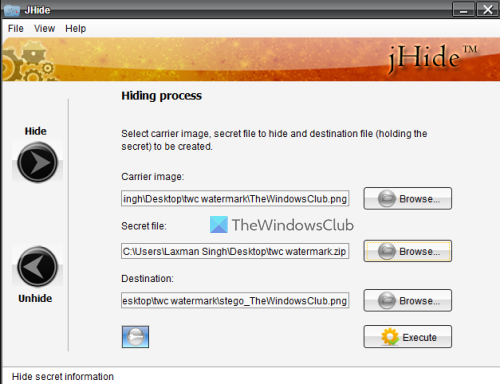
JHide is a simple and portable steganography software for Windows 11/10. This open-source tool supports TIFF, BMP, PNG, and TIF image file types for hiding text in an image. Not only just a text file, but it can also hide a ZIP file or other supported file type. You can even use this tool to hide an image in another image.
To use this steganography tool, download its JAR file from sourceforge.net. You need to install Java so that you can open the JAR file and then the tool interface will be in front of you.
Now, there are two main parts only; Hide and Unhide in this tool. Let’s check them.
Hide text file in an image
To hide a text file in an image using this tool, click on the Hide option. It will expand a Hiding process section. Here:
- Add Carrier Image or source image using the Browse button
- Press the Browse button available for the Secret file option and then you can select the TXT file or other supported file that you want to hide in the carrier image
- Select the destination where the output image file will be created containing your secret file. This tool automatically selects an output folder and image name but you can change it if needed
- Click on the Password icon and use the password field to encrypt and password protect the text file
- Finally, press the Execute button and let the process complete.
Once you get the output image, use the image as you like.
Unhide the text file from the image
To unhide or export the hidden text file from the image, click on the Unhide option available on the tool interface to expand the Unhide process section. Now follow these steps:
- Press the Browse button available for the Host image. You need to add the output image that you created to hide the text file
- Use the Browse button to select the destination where the text file will be decrypted and stored. The output is stored in a ZIP file
- Click on the Password icon or button. Enter the same password that you used to encrypt and password protect the text file for hiding
- Press the Execute button.
2] QuickStego
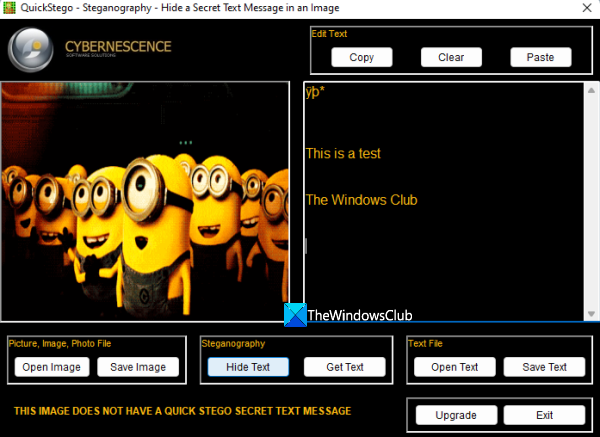
QuickStego is also a freeware for Windows 11/10 that you can use to hide a TXT file in a GIF, JPEG, BMP, or JPG image. The output image can be saved in BMP format only.
It doesn’t let you encrypt and password protect the text message before hiding it. But this steganography tool lets you edit the content of the text file before hiding that text in the output image which is a good feature.
For using this tool, download its EXE from quickcrypto.com. Install the tool and open its interface where the available options or buttons are self-explanatory. Use those options and hide/unhide text in an image and from an image. The available options are:
- An Open Image button to insert a supported image for hiding the text content. It also shows a preview of the input image. You need to use the same button to fetch the hidden text from the output image
- An Open Text button to add and show the text content of a TXT file. The text content from the selected TXT file is visible in the right section of this tool where you can edit the text if needed and save all that text message
- Hide Text button for hiding the text message in the image
- Save Image option for storing the output image in BMP format that will store your secret text
- Save Text option to fetch the hidden text content from the image and save it as a separate text file.
Related: SSuite Picsel Security lets you encrypt messages in images
3] ImageSteganography
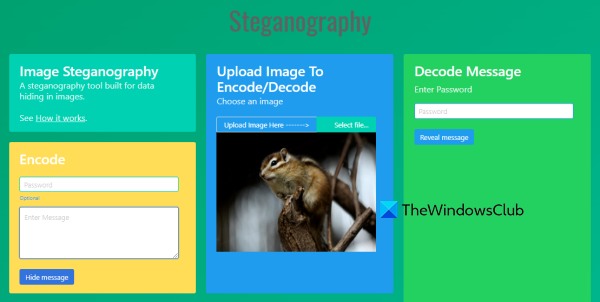
ImageSteganography is the simplest tool on this list. This is a web-based tool that requires a browser to hide a message in an image. You will have the option to encode the message which is good as you will need the same encoding key or password to reveal the concealed message when needed.
In order to use this tool, first, open its homepage from github.com. There, use the Drop-down menu button (in green color) to download its ZIP file. Extract that file and then open the index.html file in a browser.
Now the tool interface will be in front of you. There, click on the Select file button to add a supported image from your computer. Use the Encode section, add a password of your choice, and enter your message in the given text box.
Press the Hide message button and it will encrypt that text message in the image and provide you an Encoded Image on the bottom section of its interface. Right-click on the encoded image and use the Save as option to store it.
The next time when you want to reveal the hidden message, use the Select File button on its interface to add the encoded image. Enter the password in the required field, and press the Reveal message button. This will instantly show the message hidden in that image.
Read: How to write an Invisible Text Message in an Image File
4] Steganography Online
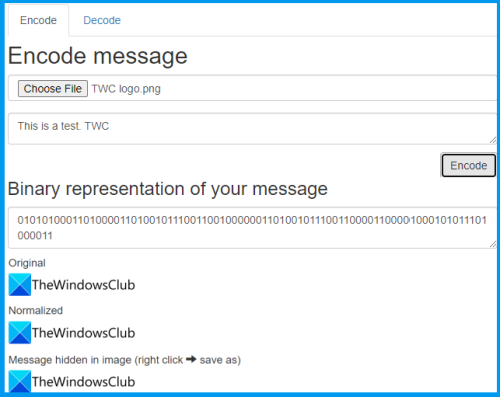
Steganography Online is one of the simplest tools on this list. This free online steganography tool comes with only two but valuable features i.e., hide text in an image and unhide secret text from an image. Your text message and image are not transmitted anywhere which is good. All the processing is done within your browser.
It doesn’t support TXT or other file types for hiding the text in an image. You need to paste or add the text message by yourself that you want to hide. Later, you can reveal hidden text from the output image using the same tool.
To hide text in an image using this tool, open its homepage from github.io. There you will have two tabs or sections (Encode and Decode) which cover everything. Let’s check how to use these sections.
In the Encode section, there is a Choose File button that you can use to add a PNG, JPG, or other supported image file. Once the image is added, the image preview is also visible on the same page. Now, use the text box to enter the message that you want to hide. The limit to adding your text message entirely depends on the image size. So, if you want to hide a large text, you should use a large size image.
After adding the message, press the Encode button. This will generate the binary representation of your text message as well as the output image that will store that text message secretly. Now, right-click on the output image and use Save as to store the image on your Windows 11/10 computer.
When you want to decode the text message stored in that image, open the homepage of this tool, and switch to the Decode tab or section. Use the Choose File button to add the image containing the secret message. Press the Decode button and hidden text will visible in a Hidden message text box. Overall, the tool works well but it shows boxes or garbage content after the decoded message. But that can be ignored.
Also read: Best File & Folder Encryption software for Windows
5] Steganography Online Codec
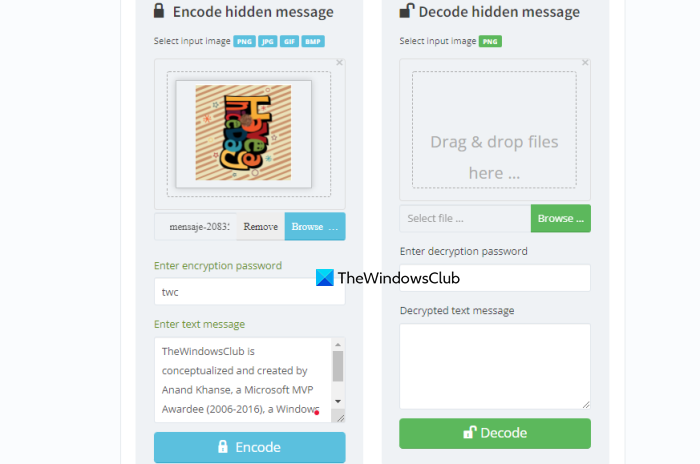
Steganography Online Codec lets you encode a hidden message in an image file using the AES 256-bit encryption algorithm. This online tool comes with a nice interface and two sections. One is used to encode a hidden message in an image and the other is for decoding the hidden message from an image.
To use it, open its homepage from pelock.com. Scroll down the interface and then you will see both the main sections. Now, on the Encode hidden message section, you can either drop a supported image file or use the Browse button. It supports a lot of image formats which include PNG, PJP, JFIF, SVGZ, WEBP, ICO, TIFF, DIB, XBM, SVG, GIF, AVIF, etc. You can see the image thumbnail after adding it.
Now enter the encryption password and the text message that you want to hide. Hit the Encode button and then you can download the output image with the encoded message as a PNG image.
To reveal the encoded message from the output image, access the Decode hidden message section of this tool. Drop the encoded image on the required box or use the Browse button. Enter the same password that you used for encoding. Press the Decode button and the revealed text will appear in the Decrypted text message box.
That’s all! Hope these tools are helpful.
Which steganography tool can be used to hide pictures?
If you need to hide a picture inside another image, then you can use a free steganography tool called JHide. We have covered the steps for using this tool in this post above. And, if you want, you can also try similar tools added in this post that let you hide a text message inside an image.
Which tool is mostly used for steganography?
There is no direct answer about which tool is mostly used for steganography. But yes, if you are looking for some steganography tools that can be used in Windows 11/10 system for hiding a text message or a text file, then you can try QuickStego, JHide, Steganography Online Codec, and other similar tools. All these tools are absolutely free to use. You can check the details of these tools above.
Read next: How to Show and Hide Text in Word.